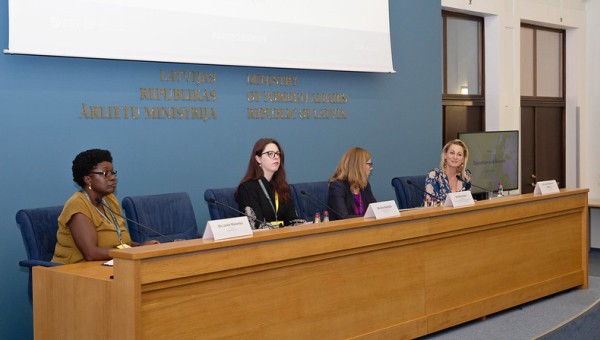JCU and PWA Host Special Class on Fashion and Sustainability
On Wednesday, February 16, John Cabot University hosted the special class “Fashion and Sustainability” in the context of Professor Antonella Salvatore’s course, “Retailing Applied to Fashion Industry.” The talk was organized in partnership with the Professional Women’s Association (PWA) and involved fashion experts from fields including journalism, law, consultancy, modeling, and management.

Fashion and Sustainability
Attorney Fabio Moretti explained that the fashion industry has a devastating impact on the ecosystem, producing billions of cubic meters of garbage and hundreds of polluting substances each year. For example, he explained that in order to grow one kilo of cotton, industries need around 20,000 liters of water. Considering that fast-fashion companies such as Zara and H&M produce between 12 and 24 collections a year, the impact that this over-production has on the environment is clear. For this reason, Moretti explained that the National Chamber for Italian Fashion has developed guidelines to encourage the use of raw materials, low-impact substances to treat fabric, and sustainable distribution and transportation strategies.
Marìa Fernanda Hernàndez Franco, head of Sustainability at LUISAVIAROMA, underlined that sustainability in fashion can also have a positive social impact. Before starting her career in the fashion world, Hernàndez Franco worked in the humanitarian field with the United Nations and other organizations. She found that fashion was missing social commitment, although it had the potential for a positive impact on society. For instance, she said that it is important to promote small designers instead of big chains and to create sustainability campaigns. Hernàndez Franco’s company launched a project in partnership with Oxfam: for every garment bought on LVRSustainable, LUISAVIAROMA would support Oxfam by donating 500 liters of water, the amount a family in a developing country needs to wash, cook, and drink for one week.
Marina Spadafora, Senior Design Consultant at Aspesi and coordinator of Fashion Revolution in Italy, said that another plague of the fashion world regards wages of people working in factories, especially in developing countries. The Fashion Revolution movement will launch a campaign to ask the European Parliament to establish a minimum living wage for workers. Spadafora further explained that the problem of child labor is prevalent in poor countries where many fashion factories are based, given that the salary earned by parents alone is not enough to support an entire family. She also spoke about design and sustainability, emphasizing the importance of avoiding synthetic materials, since they are made of oil and plastic. She also recommended using fabrics that are made of only one material, such as 100% cotton, since mixed materials cannot be recycled.
Larissa Mascarenhas, former model and now international consultant, spoke about the pros and cons of modeling. As a downside, she mentioned that models leave their families and countries in their teenage years, finding themselves in competitive environments where they are confronted with unreachable beauty standards. Of course, she said that she was also very lucky because she had the chance to travel the world, work for famous brands, and interact with different cultures. Thanks to this experience, she was able to dedicate herself to gender equality and women’s empowerment when she quit her modelling career. She decided to pursue a master’s degree focused on brand awareness and sustainability to help fashion companies meet the new standards in ethics, diversity, and inclusion.
Claudia D’Arpizio, a partner at Bain & Company, closed the roundtable by talking about the growing importance of secondhand – or “pre-loved,” items, as she defined them. Recycling is not always possible, because garments are often made of different materials and accessories contain metals. For this reason, secondhand is often the best solution. Until recently, fashion companies used to dismiss unsold stocks, whereas now they have started to pay more attention to wastefulness. She admitted that fashion brands at first feared the pre-loved trend, but now they are seeing it as an opportunity to partner with online platforms that sell secondhand items. The demand for secondhand is increasing, especially among young people, but also among collectors of luxury goods. D’Arpizio said that in the next 10 years, the industry foresees a huge growth of secondhand sales that is projected to represent 20% of a company’s revenue in 2030.
(Giorgia Tamburi)





